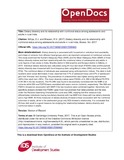Dietary Diversity and Its Relationship with Nutritional Status among Adolescents and Adults in Rural India
| dc.contributor.author | Nithya, D.J. | |
| dc.contributor.author | Bhavani, R.V. | |
| dc.date.accessioned | 2017-12-19T09:59:49Z | |
| dc.date.available | 2017-12-19T09:59:49Z | |
| dc.date.issued | 2017 | |
| dc.identifier.citation | Nithya, D.J. and Bhavani, R.V. (2017) Dietary diversity and its relationship with nutritional status among adolescents and adults in rural India, Bio soc. Sci.2017 | |
| dc.identifier.uri | https://opendocs.ids.ac.uk/opendocs/handle/20.500.12413/13448 | |
| dc.description.abstract | Dietary diversity is associated with household or individual food availability and intake of nutrients from different food groups and is an important component of nutritional outcome. This study examined the Nutrient Adequacy Ratio (NAR) and the Mean Adequacy Ratio (MAR) of three dietary diversity indices and their relationship with the nutritional status of adolescents and adults in rural regions of two states in India, Wardha district in Maharashtra and Koraput district in Odisha, in 2014. Individual dietary diversity was calculated using 24-hour diet recall (FS24hr) data and household dietary diversity was measured with food frequency data using Berry’s index (DDI) and food scores (FSFFQ). The nutritional status of individuals was assessed using anthropometric indices. The diets in both locations were cereal dominated. It was observed that 51% of adolescent boys and 27% of adolescent girls had ‘thinness’ and stunting. The prevalence of undernutrition was higher among adult women (48%) than adult men (36%). The mean diversity indices were FS24hr of 8, DDI of 89–90 and FSFFQ of 64–66 in the two locations. The FS24hr was found to be positively correlated with the NAR of all nutrients while DDI and FSFFQ were correlated with seven and six nutrients, respectively. The DDI and FS24hr showed an association with MAR if the two locations were combined together. Sensitivity and specificity analysis showed that FS24hr gave more true positives than false positives and the area under the Receiver Operating Characteristic curve was 0.68, implying that this measure truly differentiates individuals having low dietary diversity with low MAR from those with low dietary diversity and a high MAR. All three measures of dietary diversity showed a linear association with the nutritional outcomes of adults, while in the adolescent group only DDI showed a relationship. It is concluded that 24-hour diet recall is a good measure for studying the relationship between dietary diversity and nutritional status in adults. | en |
| dc.language.iso | en | en |
| dc.publisher | Cambridge University Press | en |
| dc.rights | COPYRIGHT: © Cambridge University Press, 2017: This is an Open Access article, distributed under the terms of the Creative Commons Attribution licence (http://creativecommons.org/licenses/by/4.0/), which permits unrestricted re-use, distribution, and reproduction in any medium, provided the original work is properly cited. | en |
| dc.rights.uri | http://creativecommons.org/licenses/by/4.0/ | en |
| dc.subject | Agriculture | en |
| dc.subject | Nutrition | en |
| dc.title | Dietary Diversity and Its Relationship with Nutritional Status among Adolescents and Adults in Rural India | en |
| dc.type | Article | en |
| dc.rights.holder | © Cambridge University Press, 2017 | en |
| dc.identifier.externaluri | https://doi.org/10.1017/S0021932017000463 | en |
| dc.identifier.doi | https://doi.org/10.1017/S0021932017000463 | |
| rioxxterms.funder | Default funder | en |
| rioxxterms.identifier.project | Default project | en |
| rioxxterms.version | NA | en |
| rioxxterms.versionofrecord | https://doi.org/10.1017/S0021932017000463 | en |
| rioxxterms.funder.project | 9ce4e4dc-26e9-4d78-96e9-15e4dcac0642 | en |
Files in this item
This item appears in the following Collection(s)
Except where otherwise noted, this item's license is described as COPYRIGHT: © Cambridge University Press, 2017: This is an Open Access article, distributed under the terms of the Creative Commons Attribution licence (http://creativecommons.org/licenses/by/4.0/), which permits unrestricted re-use, distribution, and reproduction in any medium, provided the original work is properly cited.


